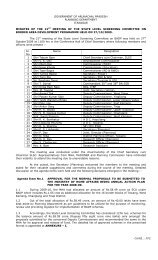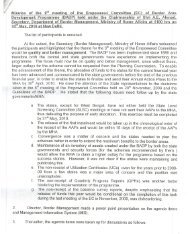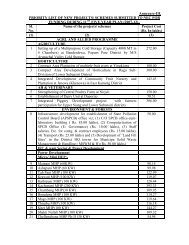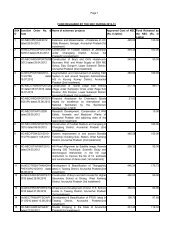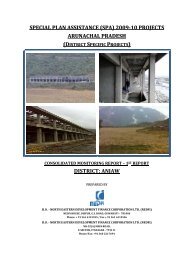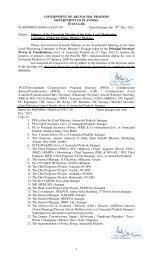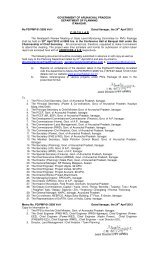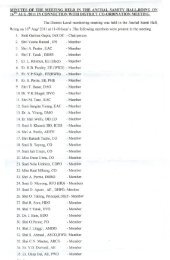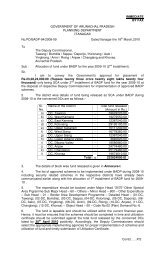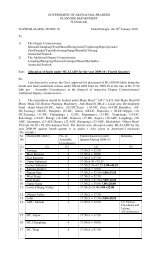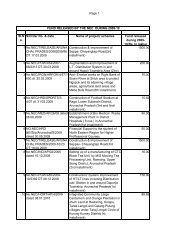Report of Task force on BADP - Department of Planning, Govt. of ...
Report of Task force on BADP - Department of Planning, Govt. of ...
Report of Task force on BADP - Department of Planning, Govt. of ...
Create successful ePaper yourself
Turn your PDF publications into a flip-book with our unique Google optimized e-Paper software.
<str<strong>on</strong>g>Task</str<strong>on</strong>g> Force for Preparati<strong>on</strong> <str<strong>on</strong>g>of</str<strong>on</strong>g> a Proposal forComprehensive Development <str<strong>on</strong>g>of</str<strong>on</strong>g> Border AreasCHAPTER IIntroducti<strong>on</strong>The land borders <str<strong>on</strong>g>of</str<strong>on</strong>g> India stretch over 15,106 kms through geo-climatic regi<strong>on</strong>s whichvary from jagged glaciers and snow clad peaks to the sand dunes <str<strong>on</strong>g>of</str<strong>on</strong>g> the border areas <str<strong>on</strong>g>of</str<strong>on</strong>g>Rajasthan. India has land borders with six countries. In many cases these borders are disputedor even undemarcated. This adds to the problem <str<strong>on</strong>g>of</str<strong>on</strong>g> harsh geographical c<strong>on</strong>diti<strong>on</strong>s. Keepingthis in view the development <str<strong>on</strong>g>of</str<strong>on</strong>g> border area is now viewed as a part <str<strong>on</strong>g>of</str<strong>on</strong>g> the comprehensiveapproach to Border Management which focuses <strong>on</strong> socio-ec<strong>on</strong>omic development andpromoti<strong>on</strong> <str<strong>on</strong>g>of</str<strong>on</strong>g> a sense <str<strong>on</strong>g>of</str<strong>on</strong>g> security am<strong>on</strong>gst the people living there.Pr<str<strong>on</strong>g>of</str<strong>on</strong>g>ile <str<strong>on</strong>g>of</str<strong>on</strong>g> the Border Area Development ProgrammeThe development <str<strong>on</strong>g>of</str<strong>on</strong>g> border areas has been a matter <str<strong>on</strong>g>of</str<strong>on</strong>g> c<strong>on</strong>cern for the country.The Border Area Development Programme (<strong>BADP</strong>) was initiated in the border areas <str<strong>on</strong>g>of</str<strong>on</strong>g>the western regi<strong>on</strong> during the Seventh Five Year Plan period for ensuring balanceddevelopment <str<strong>on</strong>g>of</str<strong>on</strong>g> border areas through development <str<strong>on</strong>g>of</str<strong>on</strong>g> infrastructure and promoti<strong>on</strong> <str<strong>on</strong>g>of</str<strong>on</strong>g> asense <str<strong>on</strong>g>of</str<strong>on</strong>g> security am<strong>on</strong>g the border populati<strong>on</strong>. The programme now covers the borderblocks <str<strong>on</strong>g>of</str<strong>on</strong>g> all the States which have internati<strong>on</strong>al land borders.<strong>BADP</strong> States:1. Arunachal Pradesh2. Assam3. Bihar4. Gujarat5. Himachal Pradesh6. Jammu & Kashmir7. Manipur8. Meghalaya9. Mizoram10. Nagaland11. Punjab12. Rajasthan13. Sikkim14. Tripura15. Uttar Pradesh16. Uttrakhand17. West Bengal1
Plan wise release <str<strong>on</strong>g>of</str<strong>on</strong>g> funds under <strong>BADP</strong> :(Rs. crore)7TH Five Year Plan (1986-1990)390.69Yearly Plan: 1990-91 80.03Yearly Plan: 1991-92 83. 7981" Five Year Plan (1992-1997) 737.009'h Five Year Plan (1997-2002) 969.001 0 Five Year Plan (2002-2007) 1754.1411 `" Five Year Plan (Year 2007-08) 520.00Allocati<strong>on</strong>s for <strong>BADP</strong>It may be seen that allocati<strong>on</strong> under <strong>BADP</strong> has been grossly inadequate to cater tothe needs <str<strong>on</strong>g>of</str<strong>on</strong>g> the border populati<strong>on</strong>. These funds could not make good the gap in ec<strong>on</strong>omicand social infrastructure and means <str<strong>on</strong>g>of</str<strong>on</strong>g> livelihood resulting from the neglect that the borderareas had faced till the Ninth Plan period. <strong>BADP</strong> was thought <str<strong>on</strong>g>of</str<strong>on</strong>g> as an additi<strong>on</strong>al centralassistance for Plan schemes to the States. The intenti<strong>on</strong> was that the State Governmentswould utilize these funds in border areas to further supplement their developmental effortsover and above the normal Plan allocati<strong>on</strong>s. However, the States interpreted <strong>BADP</strong> intheir own way treating it as <strong>on</strong>e source in the pool <str<strong>on</strong>g>of</str<strong>on</strong>g> financial resources for thedevelopment <str<strong>on</strong>g>of</str<strong>on</strong>g> the State and allocati<strong>on</strong> <str<strong>on</strong>g>of</str<strong>on</strong>g> funds to border areas under normal Planschemes was reduced and the Plan assistance under <strong>BADP</strong> became the main resource fordevelopment <str<strong>on</strong>g>of</str<strong>on</strong>g> border areas. This has <strong>on</strong>ly helped in perpetuating the status-quo and thegap between the border areas and the hinterland has remainrd. Further, the level <str<strong>on</strong>g>of</str<strong>on</strong>g>assistance under <strong>BADP</strong> did not permit undertaking major infrastructure projects. Them<strong>on</strong>ey was utilized for small schemes and programmes which has not necessarily createdany visible impact in the border areas.13
Allocati<strong>on</strong> during 1 d Plan Period:Total allocati<strong>on</strong> 10 Five Year PlanRs. 1754.14 crore(2002-2007)Per Capita allocati<strong>on</strong> per annum Rs. 97Per Sq. Km. allocati<strong>on</strong> per annum Rs.14, 447Per Village allocati<strong>on</strong> per annum Rs.1,40,331Per Block allocati<strong>on</strong> per annum Rs.98,00,000Inspecti<strong>on</strong> <str<strong>on</strong>g>of</str<strong>on</strong>g> Works under <strong>BADP</strong>The inspecti<strong>on</strong>s carried out by the <str<strong>on</strong>g>of</str<strong>on</strong>g>ficers <str<strong>on</strong>g>of</str<strong>on</strong>g> the <strong>Department</strong> <str<strong>on</strong>g>of</str<strong>on</strong>g> BorderManagement in the last three years have brought out these facts very clearly. However ithas been clearly c<strong>on</strong>veyed that the border populati<strong>on</strong> should look to <strong>BADP</strong> as theprogramme meant specifically for them to sustain their life in difficult border areas. Thereis c<strong>on</strong>tinuous demand from public representatives as also from the State Governments forenhancing allocati<strong>on</strong>s under <strong>BADP</strong>. The State Governments are also now realizing theneed for development <str<strong>on</strong>g>of</str<strong>on</strong>g> the border areas. However, their commitment is <strong>on</strong>ly to theextent that they are willing to undertake these projects provided these are fully funded bythe Central Government under <strong>BADP</strong>. State Governments perceive development <str<strong>on</strong>g>of</str<strong>on</strong>g> borderareas as the resp<strong>on</strong>sibility and priority <str<strong>on</strong>g>of</str<strong>on</strong>g> the Central Government. Hence, very little efforthas been made to fund these areas through State plan sources or to c<strong>on</strong>verge fundsavailable under Centrally Sp<strong>on</strong>sored schemes.The Inspecti<strong>on</strong> team <str<strong>on</strong>g>of</str<strong>on</strong>g> the <strong>Department</strong> <str<strong>on</strong>g>of</str<strong>on</strong>g> Border management had visited anumber <str<strong>on</strong>g>of</str<strong>on</strong>g> States. The priorities as given by the State Governments are listed below.14
State Requirement/Priority as perinspecti<strong>on</strong> reports.Gujarat Drinking Water supply and linkroads.Rajasthan Large underground tanks fordrinking water and health, kitchenfor Mid-D meal ro ramme.PunjabC<strong>on</strong>structi<strong>on</strong> <str<strong>on</strong>g>of</str<strong>on</strong>g> shed at fence gates,flood protecti<strong>on</strong> and protecti<strong>on</strong> <str<strong>on</strong>g>of</str<strong>on</strong>g>erosi<strong>on</strong> <str<strong>on</strong>g>of</str<strong>on</strong>g> soil. Power supply toborder areas.Jammu & Kashmir Roads and power supply.Residential Schools in Kargil andLeh districts, Pashmina processingunits in border areas or livelihood.Himachal Pradesh Social infrastructure, Roadc<strong>on</strong>nective /brides.UttarakhandRoad c<strong>on</strong>nectivity/bridges, health,school & higher educati<strong>on</strong> andsports.Sikkim Tourism, higher educati<strong>on</strong>,roads/bridges, soil c<strong>on</strong>servati<strong>on</strong> andpower sAssam Flood protecti<strong>on</strong>, road/bridges,drinking water, health and highereducati<strong>on</strong>.Meghalaya Road/bridges, tourism, agricultureand residential schools.Nagaland Roads/bridges, health, educati<strong>on</strong>,a riculture and animal husbandry.TripuraRoad/bridges, health, educati<strong>on</strong> andsmall shades or secure pers<strong>on</strong>nel.MizoramRoad/bridges, livelihood schemes,rain water harvesting for drinkingas well as irrigati<strong>on</strong>, animalhusbandry dairy farming, greenhouses for development <str<strong>on</strong>g>of</str<strong>on</strong>g>floriculture,15
CHAPTER IIIFuture PerspectiveIn the last decade, there has been a sea change both in ec<strong>on</strong>omicdevelopment within the country and ec<strong>on</strong>omic development <str<strong>on</strong>g>of</str<strong>on</strong>g> our neighbouringcountries. While in many <str<strong>on</strong>g>of</str<strong>on</strong>g> our neighbouring countries ec<strong>on</strong>omic developmentparticularly the development <str<strong>on</strong>g>of</str<strong>on</strong>g> communicati<strong>on</strong> and power infrastructure has beenrapid, visible and extends right to the borders, unfortunately our border populati<strong>on</strong>has been <strong>on</strong> the periphery <str<strong>on</strong>g>of</str<strong>on</strong>g> the development process.Apart from development issues , the people <str<strong>on</strong>g>of</str<strong>on</strong>g> our border areas sufferfrom multiple handicaps which include the threat <str<strong>on</strong>g>of</str<strong>on</strong>g> firing from across the borderwhich till recently haunted the border areas <str<strong>on</strong>g>of</str<strong>on</strong>g> Jammu and Kashmir; the c<strong>on</strong>structi<strong>on</strong><str<strong>on</strong>g>of</str<strong>on</strong>g> fences which has disrupted the livelihoods <str<strong>on</strong>g>of</str<strong>on</strong>g> farmers as in Punjab; influx <str<strong>on</strong>g>of</str<strong>on</strong>g>illegal immigrants as in West Bengal and Assam which has even changed thedemographic and social fabric <str<strong>on</strong>g>of</str<strong>on</strong>g> the border districts; rules and regulati<strong>on</strong>s whichinhibit the development <str<strong>on</strong>g>of</str<strong>on</strong>g> teleph<strong>on</strong>y in border areas; etc. Porous borders anddisputed and unsettled boundaries and illegal trafficking add to the problems.Guiding Principles1. Border Management in the changed c<strong>on</strong>text has to be seen as serving the bestinterests <str<strong>on</strong>g>of</str<strong>on</strong>g> the Nati<strong>on</strong> and not based merely <strong>on</strong> routine reacti<strong>on</strong>s arising out<str<strong>on</strong>g>of</str<strong>on</strong>g> reciprocity with the neighbouring countries.2. The outpost mentality should be shed and border areas should have a highstandard <str<strong>on</strong>g>of</str<strong>on</strong>g> living to serve as a demographic buffer.3. The infrastructure should not <strong>on</strong>ly cater to current needs but also includescope for further expansi<strong>on</strong>.4. The appearance <str<strong>on</strong>g>of</str<strong>on</strong>g> entry points must c<strong>on</strong>form to India's status as an emergingec<strong>on</strong>omy.16
<strong>Planning</strong> Process in Border Villages and Blocks<strong>Planning</strong> for border areas must be based <strong>on</strong> three cardinal principles: (i)Preparati<strong>on</strong> <str<strong>on</strong>g>of</str<strong>on</strong>g> a plan for border areas <strong>on</strong> participatory basis as part <str<strong>on</strong>g>of</str<strong>on</strong>g> the DistrictPlan •(ii)The plan must show the c<strong>on</strong>vergence <str<strong>on</strong>g>of</str<strong>on</strong>g> flows from other <strong>on</strong>-goingschemes and gaps in physical and social infrastructure and in livelihood opti<strong>on</strong>sshould be identified and filled through <strong>BADP</strong> and ( iii) Funds under the programmeshould be used <strong>on</strong>ly in the border blocks . Care may be taken to ensure thathabitati<strong>on</strong>s near the border(say within 10 kms. ) may be saturated first. This distancemay be determined by the state government keeping in view local circumstances. Forexample if most <str<strong>on</strong>g>of</str<strong>on</strong>g> the area within this limit is snow bound or desert and there arevery few habitati<strong>on</strong>s, these habitati<strong>on</strong> may be saturated first and then developmenteffort may be shifted to the next 10-20 km. belt. Alternately, growth nodes may beidentified within a block and a hierarchy <str<strong>on</strong>g>of</str<strong>on</strong>g> functi<strong>on</strong>s may be developed depending<strong>on</strong> the size <str<strong>on</strong>g>of</str<strong>on</strong>g> the habitati<strong>on</strong>s.The following restructuring across the board will be required to facilitate i)Assignment<str<strong>on</strong>g>of</str<strong>on</strong>g> resp<strong>on</strong>sibilities to different levels <str<strong>on</strong>g>of</str<strong>on</strong>g> PRIs for planningimplementati<strong>on</strong> and m<strong>on</strong>itoring; ii) Harm<strong>on</strong>izati<strong>on</strong> <str<strong>on</strong>g>of</str<strong>on</strong>g> existing planning andimplementati<strong>on</strong> arrangements and instituti<strong>on</strong>s with the Panchayat Raj set up; iii)Evoluti<strong>on</strong> <str<strong>on</strong>g>of</str<strong>on</strong>g> criteria for allocati<strong>on</strong> <str<strong>on</strong>g>of</str<strong>on</strong>g> funds to different levels <str<strong>on</strong>g>of</str<strong>on</strong>g> PRIs as may beappropriate; iv) Introducing enabling provisi<strong>on</strong>s to make available technical supportfor planning and implementati<strong>on</strong>; v) Introducti<strong>on</strong> <str<strong>on</strong>g>of</str<strong>on</strong>g> a comm<strong>on</strong> planning processfacilitating integrated approach to identificati<strong>on</strong> <str<strong>on</strong>g>of</str<strong>on</strong>g> problems and preparati<strong>on</strong> <str<strong>on</strong>g>of</str<strong>on</strong>g> plansfor tackling them by pooling resources from the relevant schemes.The <str<strong>on</strong>g>Report</str<strong>on</strong>g> <str<strong>on</strong>g>of</str<strong>on</strong>g> the Expert Group <strong>on</strong> <strong>Planning</strong> at the Grassroots Level(Ministry <str<strong>on</strong>g>of</str<strong>on</strong>g> Panchayati Raj, 2006) outlines the acti<strong>on</strong> programme for the EleventhFive Year Plan. Typically the process <str<strong>on</strong>g>of</str<strong>on</strong>g> decentralized planning would involve thefollowing stepsi) Needs assessment and priority setting through participatory fora like GramaSabhas and SHG networks;ii)Situati<strong>on</strong> analysis using locally available data through simple methodssupplemented by Participatory Rapid Appraisal techniques;17
iii)Resource assessments from the following sources- Own resources <str<strong>on</strong>g>of</str<strong>on</strong>g> PRIs- Untied grants from State and Central Governments- Partially tied funds from schemes like BRGF and NREGA- Schemes devolved for local level planning and implementati<strong>on</strong>- Peoples c<strong>on</strong>tributi<strong>on</strong> in cash, kind and labour- Credit linkagesiv)Formulati<strong>on</strong> <str<strong>on</strong>g>of</str<strong>on</strong>g> a visi<strong>on</strong> <str<strong>on</strong>g>of</str<strong>on</strong>g> development as well as strategies for attaining thevisi<strong>on</strong> by the PRIs through a process <str<strong>on</strong>g>of</str<strong>on</strong>g> interacti<strong>on</strong> with stakeholders andlocal experts.v) Development <str<strong>on</strong>g>of</str<strong>on</strong>g> project ideas based <strong>on</strong> the need assessment and situati<strong>on</strong>analysis by expert Working Groups at different levels <str<strong>on</strong>g>of</str<strong>on</strong>g> PRIs.vi)vii)viii)ix)C<strong>on</strong>solidati<strong>on</strong> <str<strong>on</strong>g>of</str<strong>on</strong>g> development proposals <str<strong>on</strong>g>of</str<strong>on</strong>g> the Working Groups.Prioritizati<strong>on</strong> <str<strong>on</strong>g>of</str<strong>on</strong>g> proposals and allocati<strong>on</strong> <str<strong>on</strong>g>of</str<strong>on</strong>g> resources to the prioritizedproposals.Preparati<strong>on</strong> <str<strong>on</strong>g>of</str<strong>on</strong>g> project reports in detailed formats,Vetting <str<strong>on</strong>g>of</str<strong>on</strong>g> project reports <strong>on</strong> technical and financial aspects by TechnicalAdvisory Groups <str<strong>on</strong>g>of</str<strong>on</strong>g> District <strong>Planning</strong> Committees (DPC)x) Integrati<strong>on</strong> <str<strong>on</strong>g>of</str<strong>on</strong>g> projects into local development plans by PRIs.xi)xii)C<strong>on</strong>solidati<strong>on</strong> <str<strong>on</strong>g>of</str<strong>on</strong>g> PRI Plans into District Plans.Clearance <str<strong>on</strong>g>of</str<strong>on</strong>g> the Plan by the DPC.2. Building the Administrative Capacity <str<strong>on</strong>g>of</str<strong>on</strong>g> Officials, Members <str<strong>on</strong>g>of</str<strong>on</strong>g> PanchayatiRaj Instituti<strong>on</strong>s / District Councils/Traditi<strong>on</strong>al Councils and other StakeholdersIn most <str<strong>on</strong>g>of</str<strong>on</strong>g> the border areas there is a thin presence <str<strong>on</strong>g>of</str<strong>on</strong>g> administrati<strong>on</strong>.Vacancies in the health and educati<strong>on</strong> sectors further compromise the quality <str<strong>on</strong>g>of</str<strong>on</strong>g> lifein these areas. Complete freedom must be given to the local authorities to recruitfuncti<strong>on</strong>aries for the functi<strong>on</strong>s devolved to them.Recruitment should be jobspecific. All methods should be used to filled posts by the District Administrati<strong>on</strong>18
including c<strong>on</strong>tract , deputati<strong>on</strong>, transfer , re-employment, short-term assignment, etc.The educati<strong>on</strong> norms for recruitment may also be relaxed as l<strong>on</strong>g as quality <str<strong>on</strong>g>of</str<strong>on</strong>g>service is not compromised. C<strong>on</strong>tracts may also be given to retired doctors andengineers . Similarly in the case <str<strong>on</strong>g>of</str<strong>on</strong>g> school and college teachers , retired teachers maybe employed <strong>on</strong> c<strong>on</strong>tract basis. The system <str<strong>on</strong>g>of</str<strong>on</strong>g> benefits also needs to be changed sothat people are willing to work in these areas . The following may be c<strong>on</strong>sidered : i)Liberal Special pay over and above the normal pay ; ii) Children <str<strong>on</strong>g>of</str<strong>on</strong>g> all functi<strong>on</strong>ariesworking in border areas should be given priority in Kendriya Vidyalayas, NavyugSchools and Sainik Schools. Similarly, priority should also be given in colleges,technical training schools and instituti<strong>on</strong>s <str<strong>on</strong>g>of</str<strong>on</strong>g> higher learning; iii ) In the case <str<strong>on</strong>g>of</str<strong>on</strong>g>doctors, in additi<strong>on</strong> to special pay, preference may be given in admissi<strong>on</strong>s for M.D.The Central Para-Military <str<strong>on</strong>g>force</str<strong>on</strong>g>s such as BSF, SSB, ITBP, etc. shouldliberally make their facilities available to the local populati<strong>on</strong> .In additi<strong>on</strong>, the paramilitary<str<strong>on</strong>g>force</str<strong>on</strong>g>s may be involved in community welfare schemes such as provisi<strong>on</strong> <str<strong>on</strong>g>of</str<strong>on</strong>g>medical facilities, holding medical and veterinary camps, building sports facilities,etc. These Forces have both the technical and organizati<strong>on</strong>al ability to undertakesuch tasks. For instance, during the Ninth Plan period, in Himachal Pradesh, theSSB doctors were treating the local populati<strong>on</strong> while medicines were being sourcedfrom <strong>BADP</strong>.Systematic capacity building is a neglected area and it is extremely importantthat the <str<strong>on</strong>g>of</str<strong>on</strong>g>ficials and the elected members at the village /block/district level are keptabreast <str<strong>on</strong>g>of</str<strong>on</strong>g> the latest developments in their field <str<strong>on</strong>g>of</str<strong>on</strong>g> operati<strong>on</strong> including preparati<strong>on</strong> <str<strong>on</strong>g>of</str<strong>on</strong>g>plans, delivery <str<strong>on</strong>g>of</str<strong>on</strong>g> services, etc. In the first instance a few instituti<strong>on</strong>s may beidentified <strong>on</strong> the basis <str<strong>on</strong>g>of</str<strong>on</strong>g> trained faculty, track record, experience in planning andimplementati<strong>on</strong> in border areas so that they can anchor the training programme andoversee quality. Instituti<strong>on</strong>s such as Indira Gandhi Panchayati Raj Sansthan(IGPRS), Jaipur; Centre for Research in Rural and Industrial Development,Chandigarh; Administrative Training Institute, Nainital; Nati<strong>on</strong>al Institute for RuralDevelopment (Hyderabad and Guwahati), etc. could be strengthened (trainingrelated infrastructure) to provide c<strong>on</strong>tinuous support for capacity building in borderareas . These instituti<strong>on</strong>s could be entrusted with developing training modules inc<strong>on</strong>sultati<strong>on</strong> with Ministry <str<strong>on</strong>g>of</str<strong>on</strong>g> Home Affairs and <strong>Planning</strong> Commissi<strong>on</strong> and courses19
may be c<strong>on</strong>ducted separately for various categories<str<strong>on</strong>g>of</str<strong>on</strong>g> <str<strong>on</strong>g>of</str<strong>on</strong>g>ficials/electedrepresentatives.Exposure visits and regular exchange programmes would also help thepeople <str<strong>on</strong>g>of</str<strong>on</strong>g> border areas to integrate with the rest <str<strong>on</strong>g>of</str<strong>on</strong>g> the populati<strong>on</strong>. This is speciallyimportant in the case <str<strong>on</strong>g>of</str<strong>on</strong>g> the youth.3. Criteria for Allocati<strong>on</strong> under <strong>BADP</strong>States were being funded under <strong>BADP</strong> <strong>on</strong> the basis <str<strong>on</strong>g>of</str<strong>on</strong>g> three criteria namely(i) length <str<strong>on</strong>g>of</str<strong>on</strong>g> internati<strong>on</strong>al border, (ii) populati<strong>on</strong> <str<strong>on</strong>g>of</str<strong>on</strong>g> border blocks and (iii) area <str<strong>on</strong>g>of</str<strong>on</strong>g>border blocks. However, as the programme was extended to the States borderingMyanmar, China, Bhutan and Nepal in the Ninth Plan <strong>on</strong>ly and the data for thesevariables was not available in the first two - three years <str<strong>on</strong>g>of</str<strong>on</strong>g> the plan, the allocati<strong>on</strong>sfor the newly included States were made approximately <strong>on</strong> the basis <str<strong>on</strong>g>of</str<strong>on</strong>g> the length <str<strong>on</strong>g>of</str<strong>on</strong>g>internati<strong>on</strong>al border for which informati<strong>on</strong> was available from the Ministry <str<strong>on</strong>g>of</str<strong>on</strong>g> HomeAffairs. The level <str<strong>on</strong>g>of</str<strong>on</strong>g> funding <str<strong>on</strong>g>of</str<strong>on</strong>g> the programme did not allow the use <str<strong>on</strong>g>of</str<strong>on</strong>g> the formulaas some <str<strong>on</strong>g>of</str<strong>on</strong>g> the States would stand to lose their current level <str<strong>on</strong>g>of</str<strong>on</strong>g> SCA. Hence, for theNinth Plan and the Tenth Plan period, the system <str<strong>on</strong>g>of</str<strong>on</strong>g> allocati<strong>on</strong> adopted for thenewly included States has c<strong>on</strong>tinued. Further, as per announcement , the allocati<strong>on</strong>for J&K was raised to Rs. 100 crore per year. From 2004-05, however 15%weightage has been given to hilly, desert and Rann <str<strong>on</strong>g>of</str<strong>on</strong>g> Kutch areas.In 2006-07, there was a substantial hike in the outlay from Rs. 325 crore inthe previous year to Rs. 520 crore. However, the state-wise allocati<strong>on</strong>s total <strong>on</strong>ly Rs.397.13 crore and the rest <str<strong>on</strong>g>of</str<strong>on</strong>g> the funds were to be utilized for the scheme "OptimalUtilizati<strong>on</strong> <str<strong>on</strong>g>of</str<strong>on</strong>g> Waters <str<strong>on</strong>g>of</str<strong>on</strong>g> Indus river system in J&K and for repair and maintenance <str<strong>on</strong>g>of</str<strong>on</strong>g>Headworks in Punjab" and for specific area schemes based <strong>on</strong> proposals submittedby the State Governments. Hence the original three criteria are actually not beingused to determine allocati<strong>on</strong>s.It is recommended that all the funds available in the programme aredistributed as per the extant formula and funds should not be set apart for SpecialSchemes.20
Acti<strong>on</strong> Plan : A Comprehensive and Time Bound Approacha) The aim is to saturate this area with all essential infrastructure. There are a number<str<strong>on</strong>g>of</str<strong>on</strong>g> schemes which are implemented by the State Governments as a part <str<strong>on</strong>g>of</str<strong>on</strong>g> theirnormal developmental process. In additi<strong>on</strong>, there are a number <str<strong>on</strong>g>of</str<strong>on</strong>g> flagship schemesand Bharat Nirman which focus <strong>on</strong> building <str<strong>on</strong>g>of</str<strong>on</strong>g> assets and improvement <str<strong>on</strong>g>of</str<strong>on</strong>g> socioec<strong>on</strong>omic indicators.Flagship schemes <str<strong>on</strong>g>of</str<strong>on</strong>g> the Central Government :1. Bharat Nirman (includes Rural Roads-PMGSY, Indira AwasYojana(IAY), Accelerated Rural Water Supply Programme(ARWSP), Accelerated Irrigati<strong>on</strong> Benefit Programme (AIBP),Rural Teleph<strong>on</strong>y and Rajeev Gandhi Gram in VidyutikaranYojana (RGGVV.2. Nati<strong>on</strong>al Rural Employment Guarantee Scheme (NREGS)3. Jawaharlal Nehru Nati<strong>on</strong>al Urban Renewal Missi<strong>on</strong>(JNNURM)4. Total Sanitati<strong>on</strong> Campaign (TSC,5. Nati<strong>on</strong>al Rural Health Missi<strong>on</strong> (NRHM)6. Sarva Shiksha Abhiyan (SSA)7. Mid-Day Meal Programme8. Integrated Child Development Scheme9. Backward Regi<strong>on</strong>s Grant FundThe border areas are, however, by-passed and the benefits <str<strong>on</strong>g>of</str<strong>on</strong>g> these schemes do notreach them because <str<strong>on</strong>g>of</str<strong>on</strong>g> the following: (i) The populati<strong>on</strong> norms <str<strong>on</strong>g>of</str<strong>on</strong>g> the schemes d<strong>on</strong>ot allow coverage as these areas are <str<strong>on</strong>g>of</str<strong>on</strong>g>ten thinly populated; (ii) These areas do nothave the political voice str<strong>on</strong>g enough to attract investment; and (iii) Availability<str<strong>on</strong>g>of</str<strong>on</strong>g> funds under <strong>BADP</strong> has made the State Governments c<strong>on</strong>veniently withdrawtheir own funding substituting state funds with Central funds instead <str<strong>on</strong>g>of</str<strong>on</strong>g> using themas an additi<strong>on</strong>ality. The Central Ministries have already been advised to direct theState to give priority to border areas benefits and to take a relook at theirguidelines to ensure that border areas are not neglected. The instructi<strong>on</strong>s forpreparing perspective plans dovetailed into the district plans in accordance withguidelines issued by <strong>Planning</strong> Commissi<strong>on</strong> from time to time will also help ensurec<strong>on</strong>vergence.b) The development <str<strong>on</strong>g>of</str<strong>on</strong>g> basic infrastructure is to be followed side by side withinvestments in social infrastructure, namely, educati<strong>on</strong>, health and drinking water.21
The emphasis would need to be <strong>on</strong> school educati<strong>on</strong> , both primary and sec<strong>on</strong>dary;basic health services; availability <str<strong>on</strong>g>of</str<strong>on</strong>g> drinking water through pipe line supplies <strong>on</strong>water storage tanks; c<strong>on</strong>structi<strong>on</strong> <str<strong>on</strong>g>of</str<strong>on</strong>g> community centres with recreati<strong>on</strong> facilities.c) Projects for development <str<strong>on</strong>g>of</str<strong>on</strong>g> infrastructure have to be initiated <strong>on</strong> a mega scale.This would mean c<strong>on</strong>structi<strong>on</strong> <str<strong>on</strong>g>of</str<strong>on</strong>g> border highways , link roads, extensi<strong>on</strong> <str<strong>on</strong>g>of</str<strong>on</strong>g> railwayservices and air links. A network <str<strong>on</strong>g>of</str<strong>on</strong>g> transmissi<strong>on</strong> lines for power andcommunicati<strong>on</strong> for c<strong>on</strong>nectivity would form part <str<strong>on</strong>g>of</str<strong>on</strong>g> the infrastructure needed foroverall development.d) Infrastructure and services have to be provided in such a way that these attractinvestments locally and from outside . This would require strengthening <str<strong>on</strong>g>of</str<strong>on</strong>g> bankingfacilities (NABARD/ Rural/cooperative banks) and increasing stake <str<strong>on</strong>g>of</str<strong>on</strong>g> thecommunity . The community may be involved in sharing <str<strong>on</strong>g>of</str<strong>on</strong>g> 10-15% <str<strong>on</strong>g>of</str<strong>on</strong>g> the cost <str<strong>on</strong>g>of</str<strong>on</strong>g>social infrastructure for drinking water supply; community centres , upgradati<strong>on</strong> <str<strong>on</strong>g>of</str<strong>on</strong>g>skills, vocati<strong>on</strong>al training and like.e) Development cannot be sustained without public -private partnership. Therefore, itwould be necessary to select such programmes , projects and schemes which act as atrigger for multifaceted activities in the area. Minor irrigati<strong>on</strong>, warehouses,storages , rural marketing , processing <str<strong>on</strong>g>of</str<strong>on</strong>g> local produce may be areas for privateinvestments . Similarly, private investments in educati<strong>on</strong> , sports and tourism, inschools/residential schools could also be promoted . Public-Private partnership maybe built by way <str<strong>on</strong>g>of</str<strong>on</strong>g> franchise lease /hiring basis.f) To ensure ec<strong>on</strong>omies <str<strong>on</strong>g>of</str<strong>on</strong>g> scale, it would be necessary to adopt the area specificapproach and ensuring value additi<strong>on</strong> to the local produce. This would meanidentifying local produce, raw material and traditi<strong>on</strong>al expertise. This would thenbe operati<strong>on</strong>alized <strong>on</strong> a large scale through area coverage, increased productivity,upgradati<strong>on</strong> <str<strong>on</strong>g>of</str<strong>on</strong>g> skills and by providing processing and marketing facilties.g) It would be necessary to increase the stake <str<strong>on</strong>g>of</str<strong>on</strong>g> the State Government in development<str<strong>on</strong>g>of</str<strong>on</strong>g> border areas by way <str<strong>on</strong>g>of</str<strong>on</strong>g> investments , ownership and commitment . In other words,the States may be required to make some financial commitments inimplementati<strong>on</strong> <str<strong>on</strong>g>of</str<strong>on</strong>g> the schemes in the border areas.22
h) And finally but not the last easy accessibility to border areas and removal <str<strong>on</strong>g>of</str<strong>on</strong>g>restricti<strong>on</strong>s <strong>on</strong> movement <str<strong>on</strong>g>of</str<strong>on</strong>g> the Indians would be equally important to bringattracti<strong>on</strong> to the border areas. The local area permits and restricted areas permitswould need to be reviewed.The desired levels <str<strong>on</strong>g>of</str<strong>on</strong>g> development in border areas cannot be achieved by tinkeringwith the existing programme and the allocati<strong>on</strong>s. It would be necessary to go whole hogin a time-bound manner. At present <strong>BADP</strong> guidelines allow a wide spectrum <str<strong>on</strong>g>of</str<strong>on</strong>g> activities.These include c<strong>on</strong>structi<strong>on</strong> <str<strong>on</strong>g>of</str<strong>on</strong>g> roads and projects <strong>on</strong> <strong>on</strong>e hand and producti<strong>on</strong> <str<strong>on</strong>g>of</str<strong>on</strong>g> vermicompost<strong>on</strong> the other. The basket is too big to bring in any meaningful change in theborder areas. There is need to restrict projects and schemes and make it a close endedprogramme. The basket has to be limited <strong>on</strong>ly to such areas which help in sustainabledevelopment over a period <str<strong>on</strong>g>of</str<strong>on</strong>g> time. In other words, the smaller schemes which are for thedirect benefit to specific villages need to be addressed by the State Government under theirnormal developmental activities. On the other hand, gap funding <str<strong>on</strong>g>of</str<strong>on</strong>g> largerprojects/schemes may be funded under <strong>BADP</strong>. The State Governments in normal coursedo not prioritize such schemes in border areas because <str<strong>on</strong>g>of</str<strong>on</strong>g> resource crunch and hinterlandpressures.By way <str<strong>on</strong>g>of</str<strong>on</strong>g> illustrati<strong>on</strong>, some <str<strong>on</strong>g>of</str<strong>on</strong>g> the schemes/projects to be taken up under <strong>BADP</strong>could be as below:Border RoadsIt is <str<strong>on</strong>g>of</str<strong>on</strong>g> utmost importance to undertake c<strong>on</strong>structi<strong>on</strong> <str<strong>on</strong>g>of</str<strong>on</strong>g> border roads to providec<strong>on</strong>nectivity to towns and cities. These border roads could also be described as two laneborder highways. The border highways may run parallel to the border but not necessarilyal<strong>on</strong>g the border. This will provide quick accessibility with the hinterland and help inintegrati<strong>on</strong> <str<strong>on</strong>g>of</str<strong>on</strong>g> the border populati<strong>on</strong> with the rest <str<strong>on</strong>g>of</str<strong>on</strong>g> the State.Roads c<strong>on</strong>nectivityThe villages, block and district headquarters are not directly c<strong>on</strong>nected with road ina number <str<strong>on</strong>g>of</str<strong>on</strong>g> States , particularly in the north -eastern regi<strong>on</strong> . The people have to takecircuitous route. Therefore, network <str<strong>on</strong>g>of</str<strong>on</strong>g> c<strong>on</strong>necting roads and link roads needs to be the firstpriority. The c<strong>on</strong>structi<strong>on</strong> <str<strong>on</strong>g>of</str<strong>on</strong>g> roads will include c<strong>on</strong>structi<strong>on</strong> <str<strong>on</strong>g>of</str<strong>on</strong>g> bridges over the rivers andrivulets. This road c<strong>on</strong>nectivity will do away with the isolati<strong>on</strong> <str<strong>on</strong>g>of</str<strong>on</strong>g> populati<strong>on</strong> within the23
order areas. This will also provide access to the local administrati<strong>on</strong> and provide impetusto local trade.PowerBecause <str<strong>on</strong>g>of</str<strong>on</strong>g> difficult terrain, most <str<strong>on</strong>g>of</str<strong>on</strong>g> the border areas have not been covered underThe main bottleneck is the transmissi<strong>on</strong> andthe rural electrificati<strong>on</strong> programme.distributi<strong>on</strong> lines. It would, therefore, be necessary to have a network <str<strong>on</strong>g>of</str<strong>on</strong>g> transmissi<strong>on</strong> linesin the border areas so as to cover each and every habitati<strong>on</strong>. Besides roads, power isWhereanother basic infrastructure without which development cannot be speeded up.drawing such transmissi<strong>on</strong> lines is not possible, stand al<strong>on</strong>e power generati<strong>on</strong> facility usingboth c<strong>on</strong>venti<strong>on</strong>al as well as locally available new and renewable sources <str<strong>on</strong>g>of</str<strong>on</strong>g> energy withassociated distributi<strong>on</strong> network may be provided.Telecommunicati<strong>on</strong>In the mainland, teleph<strong>on</strong>e and mobile c<strong>on</strong>nectivity is easily available and evenremote areas have been provided with transmissi<strong>on</strong> lines for telecommunicati<strong>on</strong>. On theother hand in the border areas, the facility is <strong>on</strong> a very limited scale and there are manyThe pace <str<strong>on</strong>g>of</str<strong>on</strong>g> development cannot be restricted <strong>on</strong> traditi<strong>on</strong>al securityrestricti<strong>on</strong>s.c<strong>on</strong>siderati<strong>on</strong>s and the intelligence network has to live up to the emerging situati<strong>on</strong>s.Informati<strong>on</strong> and communicati<strong>on</strong> technology is today the most important tool for ensuringefficiency and increased productivity. Therefore,tele-c<strong>on</strong>nectivity needs to be provided inborder areas which will bring people closer to each other and to the entire world and fillthem with a sense <str<strong>on</strong>g>of</str<strong>on</strong>g> security and nearness.TourismThere are a number <str<strong>on</strong>g>of</str<strong>on</strong>g> tourist spots which are frequented not <strong>on</strong>ly by borderLack <str<strong>on</strong>g>of</str<strong>on</strong>g> facilities at thesepopulati<strong>on</strong> but also people from other parts <str<strong>on</strong>g>of</str<strong>on</strong>g> the country.The <strong>Department</strong> <str<strong>on</strong>g>of</str<strong>on</strong>g> Border Management has, therefore,places restricts flow <str<strong>on</strong>g>of</str<strong>on</strong>g> tourists.been encouraging developmental activities in and around these tourist places to facilitateec<strong>on</strong>omic activities. The possibility <str<strong>on</strong>g>of</str<strong>on</strong>g> public private partnership in this sector needs to beexplored.24
Sports/Adventure SportsIn general sports somehow have not been a priority .The border populati<strong>on</strong>because <str<strong>on</strong>g>of</str<strong>on</strong>g> restricted working hours has lot <str<strong>on</strong>g>of</str<strong>on</strong>g> leisure time . To productively engage thepopulati<strong>on</strong> and in particular the youth it is necessary to encourage sports in border areas.C<strong>on</strong>structi<strong>on</strong> <str<strong>on</strong>g>of</str<strong>on</strong>g> mini open stadiums/indoor stadiums was introduced as a special schemeand has found favour with the border populati<strong>on</strong>. The border areas also provide ampleopportunities for adventure sports including rock climbing, river rafting , forest trekking,skiing and safaris (car / bike race , Camel safaris, Yak riding etc.). Encouragement <str<strong>on</strong>g>of</str<strong>on</strong>g>adventure sports will not <strong>on</strong>ly help in ec<strong>on</strong>omic activities but will also give a sense <str<strong>on</strong>g>of</str<strong>on</strong>g>bel<strong>on</strong>ging to the people.In a nutshell ,the aim is to transform border areas by reaching the multifaceteddevelopment in the other parts <str<strong>on</strong>g>of</str<strong>on</strong>g> the country to these remote areas.25
CHAPTER IVManagement <str<strong>on</strong>g>of</str<strong>on</strong>g> Border Area Development ProerammeDevelopment <str<strong>on</strong>g>of</str<strong>on</strong>g> border areas is a part <str<strong>on</strong>g>of</str<strong>on</strong>g> comprehensive approach to the BorderManagement. It is not to be seen <strong>on</strong>ly as a socio-ec<strong>on</strong>omic development but also an effortfor the security management <str<strong>on</strong>g>of</str<strong>on</strong>g> the borders. It is, therefore, necessary that the Border AreaDevelopment Programme is implemented by the <strong>Department</strong> <str<strong>on</strong>g>of</str<strong>on</strong>g> Border Managementthrough the respective border States and the Border Guarding Forces.Modificati<strong>on</strong> in <strong>BADP</strong> GuidelinesThere is need to redraft the guidelines for implementati<strong>on</strong> <str<strong>on</strong>g>of</str<strong>on</strong>g> <strong>BADP</strong> <strong>on</strong> the basis <str<strong>on</strong>g>of</str<strong>on</strong>g>the recommendati<strong>on</strong>s <str<strong>on</strong>g>of</str<strong>on</strong>g> this <str<strong>on</strong>g>Report</str<strong>on</strong>g>. The <strong>Department</strong> <str<strong>on</strong>g>of</str<strong>on</strong>g> Border Management mayundertake this exercise in c<strong>on</strong>sultati<strong>on</strong> with the State Governments. The followingchanges particularly may be incorporated :1. To facilitate implementati<strong>on</strong> funds to be released in two instalments- The firstinstalment <str<strong>on</strong>g>of</str<strong>on</strong>g> 90% to be released <strong>on</strong> receipt <str<strong>on</strong>g>of</str<strong>on</strong>g> the schemes approved for the year (based<strong>on</strong> block level plans) by the State level Screening Committee and the balance 10% when70% <str<strong>on</strong>g>of</str<strong>on</strong>g> the funds released have been spent. Funding for the subsequent year will be based<strong>on</strong> c<strong>on</strong>firmati<strong>on</strong> <str<strong>on</strong>g>of</str<strong>on</strong>g> expenditure and receipt <str<strong>on</strong>g>of</str<strong>on</strong>g> approved list <str<strong>on</strong>g>of</str<strong>on</strong>g> schemes.2. Funds must be released by the State Governments to the implementing agencies within15 days <str<strong>on</strong>g>of</str<strong>on</strong>g> receipt.Upgradati<strong>on</strong> <str<strong>on</strong>g>of</str<strong>on</strong>g> Administrative StructureThere is also need for upgradati<strong>on</strong> <str<strong>on</strong>g>of</str<strong>on</strong>g> the administrative structure dealingwith the Border Area Development Programme. A few States have set up<strong>Department</strong> <str<strong>on</strong>g>of</str<strong>on</strong>g> Border Development or with similar nomenclatures. These departmentsspecifically focus <strong>on</strong> development <str<strong>on</strong>g>of</str<strong>on</strong>g> border areas. In some <str<strong>on</strong>g>of</str<strong>on</strong>g> the State the programmeis in the domain <str<strong>on</strong>g>of</str<strong>on</strong>g> the <strong>Planning</strong> <strong>Department</strong> and in some under the Home <strong>Department</strong>.It would be desirable to have an independent department or divisi<strong>on</strong> for the borderareas under the overall charge <str<strong>on</strong>g>of</str<strong>on</strong>g> the Home <strong>Department</strong> <strong>on</strong> the lines <str<strong>on</strong>g>of</str<strong>on</strong>g> the CentralGovernment. For the field level functi<strong>on</strong>aries an incentive scheme should be devisedgiving <str<strong>on</strong>g>of</str<strong>on</strong>g> upto 25% incentive over and above their remunerati<strong>on</strong> for posting <strong>on</strong> the26
Border Blocks. It may be thought <str<strong>on</strong>g>of</str<strong>on</strong>g> as a mandatory posting at the beginning <str<strong>on</strong>g>of</str<strong>on</strong>g> theservice for the entrants to the State Civil Services. This would help in proper synergyand appreciati<strong>on</strong> <str<strong>on</strong>g>of</str<strong>on</strong>g> the problems both between the States and the Central Government.In this manner, the border areas will also get the desired level <str<strong>on</strong>g>of</str<strong>on</strong>g> attenti<strong>on</strong>.Flexibility in Executi<strong>on</strong> <str<strong>on</strong>g>of</str<strong>on</strong>g> ProgrammeIt is felt that the programme should c<strong>on</strong>tinue to be a part <str<strong>on</strong>g>of</str<strong>on</strong>g> the overalldevelopmental activities <str<strong>on</strong>g>of</str<strong>on</strong>g> the State and the scheme/ projects should be finalized inc<strong>on</strong>sultati<strong>on</strong> with the Panchayati Raj Instituti<strong>on</strong>s (PRIs). Because <str<strong>on</strong>g>of</str<strong>on</strong>g> the difficultterrain, the programmes are generally not completed as per the time schedule by theState executing agencies. It may, therefore, be necessary to involve the borderguarding <str<strong>on</strong>g>force</str<strong>on</strong>g>s in executi<strong>on</strong> <str<strong>on</strong>g>of</str<strong>on</strong>g> such scheme projects which directly benefit the area <str<strong>on</strong>g>of</str<strong>on</strong>g>their deployment. In other case, it may be necessary to involve n<strong>on</strong>-Governmentalorganizati<strong>on</strong>s, give c<strong>on</strong>tractual assignments, out source the services and also explorethe franchise system. This has to be resorted <strong>on</strong>ly where the State Governmentagencies will not be in a positi<strong>on</strong> to complete the projects because <str<strong>on</strong>g>of</str<strong>on</strong>g> their manpoweror other c<strong>on</strong>straints. Such measures can be adopted by the State Level ScreeningCommittees under the Chief Secretary <strong>on</strong> the recommendati<strong>on</strong>s <str<strong>on</strong>g>of</str<strong>on</strong>g> the districtmagistrate and the nodal department.Inspecti<strong>on</strong> <str<strong>on</strong>g>of</str<strong>on</strong>g> <strong>BADP</strong> WorksBesides, m<strong>on</strong>itoring and reporting <str<strong>on</strong>g>of</str<strong>on</strong>g> the programme, inspecti<strong>on</strong> is verycrucial. However, there is hardly any attempt by the States to undertake inspecti<strong>on</strong> <str<strong>on</strong>g>of</str<strong>on</strong>g>the programmes carried out under <strong>BADP</strong>. It is <strong>on</strong>ly at the level <str<strong>on</strong>g>of</str<strong>on</strong>g> the <strong>Department</strong> <str<strong>on</strong>g>of</str<strong>on</strong>g>Border Management that inspecti<strong>on</strong>s have been carried out in the past by the <str<strong>on</strong>g>of</str<strong>on</strong>g>ficersdealing with the subject. Programme m<strong>on</strong>itoring system should be instituti<strong>on</strong>alized.Each border block should be assigned to a high ranking State Government <str<strong>on</strong>g>of</str<strong>on</strong>g>ficial whoshould regularly visit the block and take resp<strong>on</strong>sibility not <strong>on</strong>ly for <strong>BADP</strong> schemes butalso for all schemes being implemented in the block. The district magistrate shouldalso be made resp<strong>on</strong>sible for inspecti<strong>on</strong> <str<strong>on</strong>g>of</str<strong>on</strong>g> the projects being carried out in his district.He will also be resp<strong>on</strong>sible for preparati<strong>on</strong> <str<strong>on</strong>g>of</str<strong>on</strong>g> the schemes and projects in aparticipatory mode as given earlier in this report and the m<strong>on</strong>ey routed through him toenable him to have the supervisory c<strong>on</strong>trol.27
Third party inspecti<strong>on</strong> is also recommended for an independent feed back<strong>on</strong> the quality <str<strong>on</strong>g>of</str<strong>on</strong>g> work.Management Informati<strong>on</strong> SystemThe sustained efforts for development <str<strong>on</strong>g>of</str<strong>on</strong>g> border areas would requirec<strong>on</strong>stant m<strong>on</strong>itoring and reporting.The Management Informati<strong>on</strong> System (MIS),therefore, needs to be developed with village as the basic unit.The ManagementInformati<strong>on</strong> System has to be web enabled for regular up-date by the respective States.The system may be designed in such a way that besides taking into c<strong>on</strong>siderati<strong>on</strong>, thesecurity aspects <str<strong>on</strong>g>of</str<strong>on</strong>g> the MIS, the required reports are generated for policy decisi<strong>on</strong> sothat mid stream correcti<strong>on</strong>s are made wherever required.Ministries <str<strong>on</strong>g>of</str<strong>on</strong>g> the CentralGovernment which are implementing the flagship schemes and the RGI have alreadycreated a data base.Appropriate linkages <str<strong>on</strong>g>of</str<strong>on</strong>g> the available data base with <strong>BADP</strong> MISTherefore, the need is to harvest the informati<strong>on</strong> already available.are required.Nati<strong>on</strong>al Informatics Centre may be made the nodal <strong>Department</strong> which in turn maydecide the modalities for executi<strong>on</strong> <str<strong>on</strong>g>of</str<strong>on</strong>g> MIS in c<strong>on</strong>sultati<strong>on</strong> with the <strong>Department</strong> BorderManagement.Transparency, ICT and Media PolicyOne <str<strong>on</strong>g>of</str<strong>on</strong>g> the important planks for winning the support and c<strong>on</strong>fidence <str<strong>on</strong>g>of</str<strong>on</strong>g> thelocal populati<strong>on</strong> is transparency in all aspects <str<strong>on</strong>g>of</str<strong>on</strong>g> development planning and executi<strong>on</strong>.The flow <str<strong>on</strong>g>of</str<strong>on</strong>g> funds at each level, the choice <str<strong>on</strong>g>of</str<strong>on</strong>g> schemes and their locati<strong>on</strong>s, tenderingprocess, stage <str<strong>on</strong>g>of</str<strong>on</strong>g> implementati<strong>on</strong>, etc. should be given wide publicity not <strong>on</strong>ly throughwebsites but also through boards at Panchayat Offices and at project sites. Informati<strong>on</strong>communicati<strong>on</strong> technology should be used al<strong>on</strong>gwith an imaginative media policy toensure that informati<strong>on</strong> related to the programme is available to everybody. Localdialects and percepti<strong>on</strong>s should be used to prevent disinformati<strong>on</strong> andculture,Funds under the programme may also be used to make lifesubversive propaganda.easier for the border populati<strong>on</strong> so that access to licences, land records, rati<strong>on</strong> cards,photo identity cards and other such documents is streamlined.28
CHAPTER VC<strong>on</strong>clusi<strong>on</strong>s and Recommendati<strong>on</strong>sThe liberalizati<strong>on</strong> <str<strong>on</strong>g>of</str<strong>on</strong>g> the ec<strong>on</strong>omy starting from the early 90s, emergence <str<strong>on</strong>g>of</str<strong>on</strong>g> thecountry as an ec<strong>on</strong>omic power, improvement in relati<strong>on</strong>s with neighbouring countries andnecessity <str<strong>on</strong>g>of</str<strong>on</strong>g> vigorous border trade and transit, changed the perspective in which borderareas are perceived. The Kargil War, subsequent c<strong>on</strong>fidence building measures, and theextensive development <strong>on</strong> the other side <str<strong>on</strong>g>of</str<strong>on</strong>g> the borders <str<strong>on</strong>g>of</str<strong>on</strong>g> the country led to a reversal inthe strategic policy and planning <strong>on</strong> border management. It is now felt that borders should"show case" the development <str<strong>on</strong>g>of</str<strong>on</strong>g> the country. The borders should be populated, and madeaccessible to the people <str<strong>on</strong>g>of</str<strong>on</strong>g> the country. This changed perspective needs new policies andstrategies for Border Management. Thus, ec<strong>on</strong>omic development, technologicaladvancement and world class infrastructure and services in border areas should be the keycomp<strong>on</strong>ents <str<strong>on</strong>g>of</str<strong>on</strong>g> border management policies and strategies.1. Guiding PrinciplesBorder Area Development and Management should be based <strong>on</strong> the followingprinciples :■Border Management in the changed c<strong>on</strong>text has to be seen as serving the bestinterests <str<strong>on</strong>g>of</str<strong>on</strong>g> the Nati<strong>on</strong> and not based merely <strong>on</strong> routine reacti<strong>on</strong>s arising out <str<strong>on</strong>g>of</str<strong>on</strong>g>reciprocity with the neighbouring countries.• The outpost mentality should be shed and border areas should have a highstandard <str<strong>on</strong>g>of</str<strong>on</strong>g> living and serve as a demographic buffer.• The infrastructure should not <strong>on</strong>ly cater to current needs but also include scopefor further expansi<strong>on</strong>.■The appearance <str<strong>on</strong>g>of</str<strong>on</strong>g> entry points must c<strong>on</strong>form to India's status as an emergingec<strong>on</strong>omy.2. Spatial Spread <str<strong>on</strong>g>of</str<strong>on</strong>g> FundsFunds under the Border Area Development Programme should be used <strong>on</strong>ly inthe border blocks. First priority should be given to villages <strong>on</strong> the border.29
3. Quantum <str<strong>on</strong>g>of</str<strong>on</strong>g> FundingThe Border areas need massive investment to bring them <strong>on</strong> par with the betterdeveloped parts <str<strong>on</strong>g>of</str<strong>on</strong>g> the country. The allocati<strong>on</strong> for the Border Area DevelopmentProgramme should be increased to at least Rs. 1000 crore per annum to at least take care<str<strong>on</strong>g>of</str<strong>on</strong>g> the critical gaps in physical and social infrastructure and to provide livelihoodopportunities. In additi<strong>on</strong>, the norms <str<strong>on</strong>g>of</str<strong>on</strong>g> Centrally Sp<strong>on</strong>sored Schemes particularly,Bharat Nirman and the Flagship Schemes should be relaxed so that smaller dispersedhabitati<strong>on</strong>s in border areas can also be covered. Further, priority should be given in theplans prepared for each scheme to the border blocks and villages. In additi<strong>on</strong>, a statewiseplan may be drawn up for roads, electricity and telecommunicati<strong>on</strong>s in the borderareas and funded separately.4. <strong>Planning</strong> for Border AreasThe Border area plan should be a part <str<strong>on</strong>g>of</str<strong>on</strong>g> the district plan based <strong>on</strong> the followingcardinal principles :• <strong>Planning</strong> and implementati<strong>on</strong> <strong>on</strong> participatory basis by Panchayati RajInstituti<strong>on</strong>s/Aut<strong>on</strong>omous Councils/Other local bodies.■C<strong>on</strong>vergence <str<strong>on</strong>g>of</str<strong>on</strong>g> all Centrally Sp<strong>on</strong>sored Schemes with <strong>BADP</strong> funds being usedfor filling critical gaps in infrastructure and for providing livelihoodopportunities• The process <str<strong>on</strong>g>of</str<strong>on</strong>g> decentralized planning as given in the <str<strong>on</strong>g>Report</str<strong>on</strong>g> <str<strong>on</strong>g>of</str<strong>on</strong>g> the ExpertGroup <strong>on</strong> <strong>Planning</strong> at the Grassroots Level(Ministry <str<strong>on</strong>g>of</str<strong>on</strong>g> Panchayati Raj, 2006)should be followed. This is based <strong>on</strong> a visi<strong>on</strong> for the local area and needsassessment and priority setting through participatory fora like Grama Sabhasand SHG networks; resource assessment from all sources including ownresources <str<strong>on</strong>g>of</str<strong>on</strong>g> the local bodies; prioritizati<strong>on</strong> <str<strong>on</strong>g>of</str<strong>on</strong>g> proposals and allocati<strong>on</strong> <str<strong>on</strong>g>of</str<strong>on</strong>g>resources to the prioritized proposals; preparati<strong>on</strong> <str<strong>on</strong>g>of</str<strong>on</strong>g> project reports in detailedformats; vetting <str<strong>on</strong>g>of</str<strong>on</strong>g> project reports <strong>on</strong> technical and financial aspects byTechnical Advisory Groups <str<strong>on</strong>g>of</str<strong>on</strong>g> District <strong>Planning</strong> Committees (DPC); integrati<strong>on</strong><str<strong>on</strong>g>of</str<strong>on</strong>g> projects into plans by PRIs; and clearance <str<strong>on</strong>g>of</str<strong>on</strong>g> the Plan by the DPC.30
5. Building the Administrative Capacity <str<strong>on</strong>g>of</str<strong>on</strong>g> <str<strong>on</strong>g>of</str<strong>on</strong>g>ficials, members <str<strong>on</strong>g>of</str<strong>on</strong>g> PanchayatiRaj Instituti<strong>on</strong>s / district councils/traditi<strong>on</strong>al councils,etcOne <str<strong>on</strong>g>of</str<strong>on</strong>g> the major problems in the delivery <str<strong>on</strong>g>of</str<strong>on</strong>g> services in border areas is thethin presence <str<strong>on</strong>g>of</str<strong>on</strong>g> administrati<strong>on</strong> and pers<strong>on</strong>nel in vital sectors like health andeducati<strong>on</strong>. Complete freedom must be given to the local authorities to recruitfuncti<strong>on</strong>aries for the functi<strong>on</strong>s devolved to them. Recruitment should be jobspecific and eligibility norms may be relaxed as l<strong>on</strong>g as quality is not compromised.The system <str<strong>on</strong>g>of</str<strong>on</strong>g> benefits also needs to be changed so that people are willing to workin these areas. The following may be c<strong>on</strong>sidered : i) Liberal Special pay over andabove normal pay ; and ii) Children <str<strong>on</strong>g>of</str<strong>on</strong>g> all functi<strong>on</strong>aries working in border areasshould be given priority in Kendriya Vidyalayas, Navyug Schools and SainikSchools. Similarly, priority should also be given in colleges and other instituti<strong>on</strong>s <str<strong>on</strong>g>of</str<strong>on</strong>g>higher learning. Further, Central Para-Military <str<strong>on</strong>g>force</str<strong>on</strong>g>s such as BSF, SSB, ITBP, etc.should liberally make their facilities available to the local populati<strong>on</strong>.Systematic capacity building is a neglected area and it is extremelyimportant that the <str<strong>on</strong>g>of</str<strong>on</strong>g>ficials and the elected members at the village/block/districtlevel are kept abreast with the latest developments in their field <str<strong>on</strong>g>of</str<strong>on</strong>g> operati<strong>on</strong>including preparati<strong>on</strong> <str<strong>on</strong>g>of</str<strong>on</strong>g> plans, delivery <str<strong>on</strong>g>of</str<strong>on</strong>g> services, etc. In the first instance a fewinstituti<strong>on</strong>s may be identified <strong>on</strong> the basis <str<strong>on</strong>g>of</str<strong>on</strong>g> trained faculty, track record, experiencein planning and implementati<strong>on</strong> in border areas so that they can anchor the trainingprogramme and oversee quality. Exposure visits and regular exchange programmeswould also help the people <str<strong>on</strong>g>of</str<strong>on</strong>g> border areas to integrate with the rest <str<strong>on</strong>g>of</str<strong>on</strong>g> thepopulati<strong>on</strong>. This is specially important in the case <str<strong>on</strong>g>of</str<strong>on</strong>g> the youth.6. Fund FlowIt is recommended that all the funds available in the programme aredistributed as per the extant formula and funds should not be set apart forSpecial Schemes.Funds to be released in two instalments- The first instalment <str<strong>on</strong>g>of</str<strong>on</strong>g> 90% to bereleased <strong>on</strong> receipt <str<strong>on</strong>g>of</str<strong>on</strong>g> the schemes approved for the year (based <strong>on</strong> blocklevel plans) by the State level Screening Committee and the balance 10%when 70% <str<strong>on</strong>g>of</str<strong>on</strong>g> the funds released have been spent. Funding for the31
subsequent year will be based <strong>on</strong> c<strong>on</strong>firmati<strong>on</strong> <str<strong>on</strong>g>of</str<strong>on</strong>g> expenditure and receipt<str<strong>on</strong>g>of</str<strong>on</strong>g> approved list <str<strong>on</strong>g>of</str<strong>on</strong>g> schemes.7. M<strong>on</strong>itoring and Inspecti<strong>on</strong>Besides, m<strong>on</strong>itoring and reporting <str<strong>on</strong>g>of</str<strong>on</strong>g> the programme, inspecti<strong>on</strong> is verycrucial. However, there is hardly any attempt by the States to undertake inspecti<strong>on</strong> <str<strong>on</strong>g>of</str<strong>on</strong>g>the programmes carried out under <strong>BADP</strong>. It is <strong>on</strong>ly at the level <str<strong>on</strong>g>of</str<strong>on</strong>g> the <strong>Department</strong> <str<strong>on</strong>g>of</str<strong>on</strong>g>Border Management that inspecti<strong>on</strong>s have been carried out in the past by the <str<strong>on</strong>g>of</str<strong>on</strong>g>ficersdealing with the subject. Programme m<strong>on</strong>itoring system should be instituti<strong>on</strong>alized.Each border block should be assigned to a high ranking State Government <str<strong>on</strong>g>of</str<strong>on</strong>g>ficial whoshould regularly visit the block and take resp<strong>on</strong>sibility not <strong>on</strong>ly for <strong>BADP</strong> schemes butalso for all schemes being implemented in the block. The district magistrate shouldalso be made resp<strong>on</strong>sible for inspecti<strong>on</strong> <str<strong>on</strong>g>of</str<strong>on</strong>g> the projects being carried out in his district.He will also be resp<strong>on</strong>sible for preparati<strong>on</strong> <str<strong>on</strong>g>of</str<strong>on</strong>g> the schemes and projects in aparticipatory mode as given earlier in this report and the m<strong>on</strong>ey routed through him toenable him to have the supervisory c<strong>on</strong>trol. Third party inspecti<strong>on</strong> is alsorecommended for an independent feed back <strong>on</strong> the quality <str<strong>on</strong>g>of</str<strong>on</strong>g> work.8. Transparency, ICT and Media PolicyOne <str<strong>on</strong>g>of</str<strong>on</strong>g> the important planks for winning the support and c<strong>on</strong>fidence <str<strong>on</strong>g>of</str<strong>on</strong>g> thelocal populati<strong>on</strong> is transparency in all aspects <str<strong>on</strong>g>of</str<strong>on</strong>g> development planning and executi<strong>on</strong>.The flow <str<strong>on</strong>g>of</str<strong>on</strong>g> funds at each level, the choice <str<strong>on</strong>g>of</str<strong>on</strong>g> schemes and their locati<strong>on</strong>s, tenderingprocess, stage <str<strong>on</strong>g>of</str<strong>on</strong>g> implementati<strong>on</strong>, etc. should be given wide publicity not <strong>on</strong>ly throughwebsites but also through boards at Panchayat Offices and at project sites. Informati<strong>on</strong>communicati<strong>on</strong> technology should be used al<strong>on</strong>gwith an imaginative media policy toensure that informati<strong>on</strong> related to the programme is available to everybody. Localculture, dialects and percepti<strong>on</strong>s should be used to prevent disinformati<strong>on</strong> andsubversive propaganda. Funds under the programme may also be used to make lifeeasier for the border populati<strong>on</strong> so that access to licences, land records, rati<strong>on</strong> cards,photo identity cards and other such documents is streamlined.32
Annexure - AStatement showing the districts, blocks, villages, populati<strong>on</strong> and area covered under <strong>BADP</strong>Positi<strong>on</strong> as <strong>on</strong> 30.04.07SI.No.Name <str<strong>on</strong>g>of</str<strong>on</strong>g> StateNo.<str<strong>on</strong>g>of</str<strong>on</strong>g>DistrictsTotal No, <str<strong>on</strong>g>of</str<strong>on</strong>g>BlocksTotal No.<str<strong>on</strong>g>of</str<strong>on</strong>g> villagescoveredTotalPopulati<strong>on</strong>CoveredTotal Areacovered (insq. km.)Length <str<strong>on</strong>g>of</str<strong>on</strong>g>Internati<strong>on</strong>alBorder (Survey<str<strong>on</strong>g>of</str<strong>on</strong>g> India)1. ArunachalPradesh12 31 1237 257342 36793.47 1863.002. Assam 7 25 3019393 5130.32 530.003. Bihar 7 31 2090 52 00127 6787.74 729.004, Gujarat 3 8 895 1354615 18024.70 508.005. HimachalPradesh2 3 241 62383 12643.00 201.006. J&K 9 44 2614 2546356 7565.66 9928.007. Manipur 3 8 637 264031 8093.00 398.008. Meghalaya 5 12 1523 427674 4890.00 443.009. Mizoram 6 16 488 344322 14566.35 828.0010. Nagaland 4 7 159 208745 1884 .26 215.0011. Punjab 4 18 1837 1955430 6197.21 553.0012. Rajasthan 4 14 3685 3246145 73498.38 1037.0013. Sikkim 3 24• 35181 204.23 351.0014. Tripura 4 24 676 1944174 6402.50 856.0015. Uttar Pradesh 7 19 2222 3583158 7786.66 607.0016. Uttarakhand 5 9 1063 504634 15148.00 560.0017. West Bengal 9 65 4595 11194169 16620.86 2499.70Total 94 358 23962 36147879 242236.3 15106.70* Informati<strong>on</strong> not received from the State Government33
No, M-13053<strong>BADP</strong>/2005-MLPGovernment <str<strong>on</strong>g>of</str<strong>on</strong>g> India<strong>Planning</strong> Commissi<strong>on</strong>(MLP Divisi<strong>on</strong>)Yojana Bhavan, Sansad MargNew Delhi - 110 001.Dated : January 5, 2006.ORDERSubject :<str<strong>on</strong>g>Task</str<strong>on</strong>g> Force for Preparati<strong>on</strong> <str<strong>on</strong>g>of</str<strong>on</strong>g> a Proposal for Comprehensive Development <str<strong>on</strong>g>of</str<strong>on</strong>g>Border Areas over the next 3-4 yearsIn pursuance <str<strong>on</strong>g>of</str<strong>on</strong>g> the decisi<strong>on</strong> taken by the Prime Minister, a <str<strong>on</strong>g>Task</str<strong>on</strong>g> Force is being set-upfor preparati<strong>on</strong> <str<strong>on</strong>g>of</str<strong>on</strong>g> a proposal for comprehensive development <str<strong>on</strong>g>of</str<strong>on</strong>g> Border Areas over thenext 3-4 years.2. The compositi<strong>on</strong> <str<strong>on</strong>g>of</str<strong>on</strong>g> the <str<strong>on</strong>g>Task</str<strong>on</strong>g> Force is as under :i) Member, <strong>Planning</strong> Commissi<strong>on</strong> (Shri B.N. Yugandhar) -Memberii) Defence Secretary- Memberiii) Secretary, Ministry <str<strong>on</strong>g>of</str<strong>on</strong>g> External AffairsMemberiv) Secretary, <strong>Department</strong> <str<strong>on</strong>g>of</str<strong>on</strong>g> ExpenditureMemberv) Secretary, <strong>Department</strong> <str<strong>on</strong>g>of</str<strong>on</strong>g> Border Management- Membervi) Secretary, Ministry <str<strong>on</strong>g>of</str<strong>on</strong>g> Powervii) Secretary, <strong>Department</strong> <str<strong>on</strong>g>of</str<strong>on</strong>g> Road, Transport and Highways - MemberMemberviii) Representative <str<strong>on</strong>g>of</str<strong>on</strong>g> Government <str<strong>on</strong>g>of</str<strong>on</strong>g> Arunachal Pradesh -Memberix) Representative <str<strong>on</strong>g>of</str<strong>on</strong>g> Government <str<strong>on</strong>g>of</str<strong>on</strong>g> Jammu & Kashmir -Memberx) Representative <str<strong>on</strong>g>of</str<strong>on</strong>g> Government <str<strong>on</strong>g>of</str<strong>on</strong>g> PunjabMemberxi) Representative <str<strong>on</strong>g>of</str<strong>on</strong>g> Government <str<strong>on</strong>g>of</str<strong>on</strong>g> RajasthanMemberxii) Representative <str<strong>on</strong>g>of</str<strong>on</strong>g> Government <str<strong>on</strong>g>of</str<strong>on</strong>g> Tripuraxiii) Representative <str<strong>on</strong>g>of</str<strong>on</strong>g> Government <str<strong>on</strong>g>of</str<strong>on</strong>g> Uttaranchal - MemberNote : Ministries/States may nominate Senior Officers(<str<strong>on</strong>g>of</str<strong>on</strong>g> the rank <str<strong>on</strong>g>of</str<strong>on</strong>g> Joint Secretary &above), who are experts regarding Border Areas.(c<strong>on</strong>td. Page 2)34
3. The Terms <str<strong>on</strong>g>of</str<strong>on</strong>g> Reference <str<strong>on</strong>g>of</str<strong>on</strong>g> the <str<strong>on</strong>g>Task</str<strong>on</strong>g> Force are as follows :I. To assess/analyse the design, planning and implementati<strong>on</strong> <str<strong>on</strong>g>of</str<strong>on</strong>g> the Border AreaDevelopment Programme (<strong>BADP</strong>) and suggest modificati<strong>on</strong>s.2. To c<strong>on</strong>sider providing the latest requisites in the border areas/villages in thelight <str<strong>on</strong>g>of</str<strong>on</strong>g> technological advancement, security requirement and internati<strong>on</strong>alexperience.3. To c<strong>on</strong>sider providing basic minimum amenities and livelihood support in each<str<strong>on</strong>g>of</str<strong>on</strong>g> the border village.4. To c<strong>on</strong>sider requirements and facilities for border trade and for enhancing thesocial and ec<strong>on</strong>omic life <str<strong>on</strong>g>of</str<strong>on</strong>g> the border populati<strong>on</strong>.5. To suggest c<strong>on</strong>vergence <str<strong>on</strong>g>of</str<strong>on</strong>g> the flagship schemes <str<strong>on</strong>g>of</str<strong>on</strong>g> Government <str<strong>on</strong>g>of</str<strong>on</strong>g> India suchas Bharat Nirman, Rural Health Missi<strong>on</strong>, Sarva Shiksha Abhiyan, Nati<strong>on</strong>alEmployment Guarantee Scheme, Core Infrastructure schemes, etc. in borderareas with a pre-defined time frame.6. To suggest activities/programmes which would facilitate visit to border areasby hinterland populati<strong>on</strong> particularly the younger generati<strong>on</strong>/7. Any other item relevant to the objective <str<strong>on</strong>g>of</str<strong>on</strong>g> the Border Area DevelopmentProgramme (<strong>BADP</strong>).-2-ToChairman and all Members <str<strong>on</strong>g>of</str<strong>on</strong>g> the <str<strong>on</strong>g>Task</str<strong>on</strong>g> GroupCopy to :I. Principal Secretary to the Prime Minister(K.K. Chhabra)Under Secretary to the <strong>Govt</strong>. <str<strong>on</strong>g>of</str<strong>on</strong>g> India2. PSs to Deputy Chairman/Minister <str<strong>on</strong>g>of</str<strong>on</strong>g> State/Members/Member-Secretary,<strong>Planning</strong> Commissi<strong>on</strong>3. All Principal Advisers/Advisers/JS(SP ), <strong>Planning</strong> Commissi<strong>on</strong>4. The <str<strong>on</strong>g>Task</str<strong>on</strong>g> Force will submit its report within 2 m<strong>on</strong>ths from the date <str<strong>on</strong>g>of</str<strong>on</strong>g> its c<strong>on</strong>stituti<strong>on</strong>.5. The <str<strong>on</strong>g>Task</str<strong>on</strong>g> Force will have powers to co-opt Members, who are experts in thedevelopment <str<strong>on</strong>g>of</str<strong>on</strong>g> Border Areas.6. Each Ministry/<strong>Department</strong> should make a presentati<strong>on</strong> to the <str<strong>on</strong>g>Task</str<strong>on</strong>g> Force <strong>on</strong> thepossibilities that exist in their areas <str<strong>on</strong>g>of</str<strong>on</strong>g> c<strong>on</strong>cern7. The <str<strong>on</strong>g>Task</str<strong>on</strong>g> Force will be serviced by the <strong>Planning</strong> Commissi<strong>on</strong>.Sd\-Sd\-(K.K. Chhabra)Under Secretary to the <strong>Govt</strong>. <str<strong>on</strong>g>of</str<strong>on</strong>g> India35



